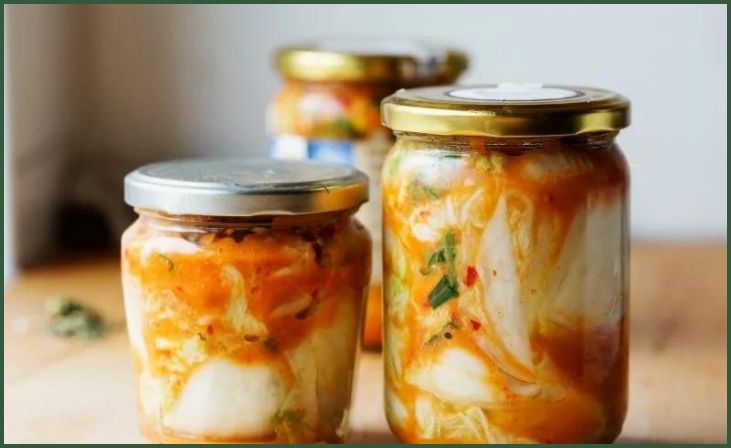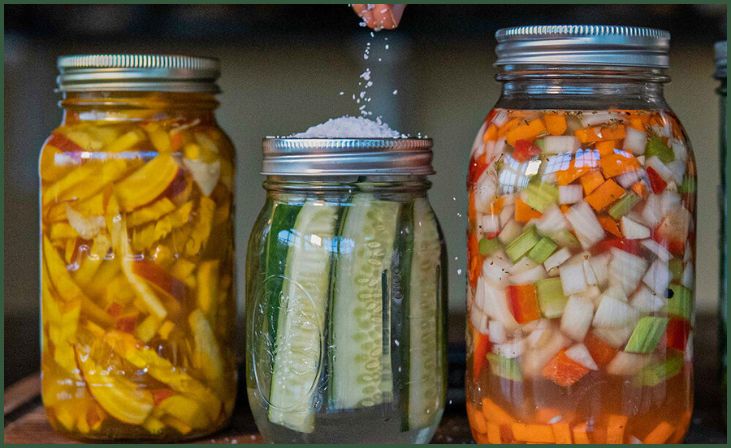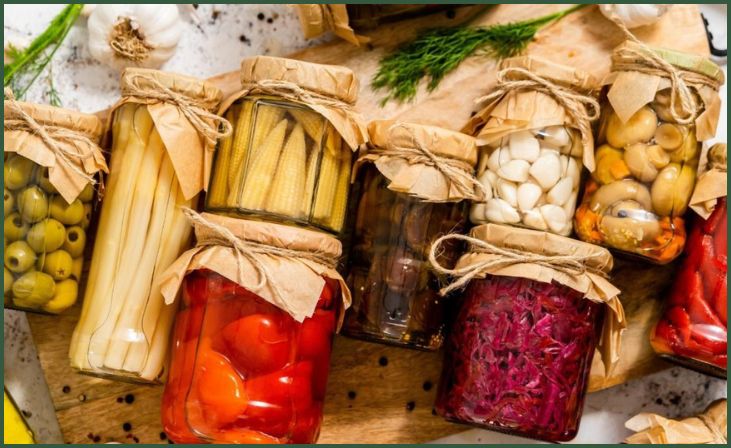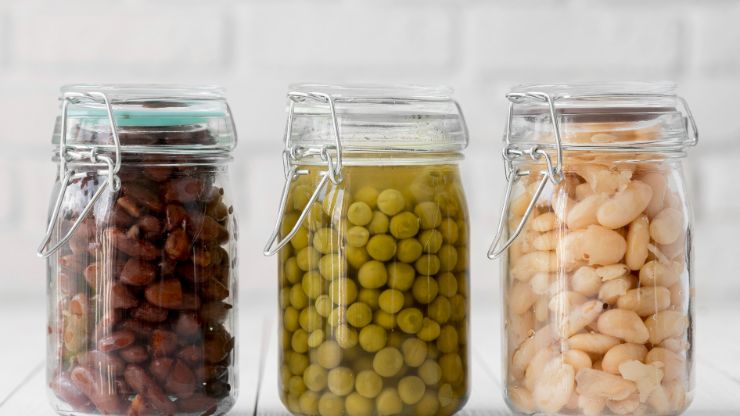Lacto-Fermentation Versus Canning And Pickling – Welcome to the definitive guide comparing Lacto-Fermentation to Canning and Pickling. If you’ve ever wondered about the art of preserving your cherished fruits and vegetables, you’re in for a treat. In the following pages, we’ll meticulously dissect the nuances of these two highly regarded preservation methods and assist you in pinpointing the one that aligns best with your requirements.
Whether you’re an experienced gastronome or just dipping your toes into the world of culinary adventures, this article is your compass through the fascinating realm of food preservation.
Table of Contents
ToggleLacto-Fermentation:

Process: Lacto-fermentation is a traditional method of food preservation that harnesses the power of beneficial bacteria, primarily Lactobacillus. These bacteria are naturally present on the surface of fruits and vegetables or can be introduced through a starter culture. In a controlled environment, these bacteria convert the sugars in the food into lactic acid. This drop in pH (acidification) creates an environment where harmful bacteria cannot thrive, thus acting as a natural preservative.
Also Read:- Salt-Preserved Limes
Taste: Lacto-fermented foods often have a distinct tangy and complex flavor profile. This unique taste is a result of the metabolic activity of the lactic acid bacteria, which not only preserve the food but also produce various flavorful compounds. These foods can range from mildly tangy to quite sour, depending on the fermentation time and conditions.
Health Benefits: Lacto-fermented foods are rich in probiotics, which are beneficial microorganisms that can aid in gut health. These probiotics can improve digestion, boost the immune system, and contribute to overall well-being. Additionally, fermented foods may be easier to digest for some individuals.
Texture: During the fermentation process, the texture of the food can change. Vegetables, for instance, may become softer or develop a more complex mouthfeel. This transformation in texture is a result of enzymatic reactions that break down some of the food’s components.
Canning:
Process: Canning is a preservation method that involves sealing food in jars or cans and then subjecting them to heat. The heat kills bacteria, molds, and yeasts, preventing spoilage and decay. There are two primary methods: water bath canning, suitable for high-acid foods like fruits and pickles, and pressure canning, necessary for low-acid foods like meats and vegetables.
Taste: Canned foods are known for retaining their original flavor and texture quite well. This is because the canning process doesn’t introduce the same acidifying or enzymatic changes that occur in fermentation. As a result, the taste remains close to the fresh state.
Longevity: Canned foods have an extended shelf life, often lasting several years when stored properly. They are hermetically sealed and don’t require refrigeration until the container is opened.
Preservation: Canning is a highly effective method for preserving foods over extended periods. It’s particularly useful for food items that you want to store for an extended duration without a significant change in flavor or texture.
Pickling:

Process: Pickling is a versatile preservation method that involves immersing food in a brine (saltwater) or a vinegar solution. It can be done through fermentation (lacto-fermentation) or quick pickling using vinegar. Quick pickling is faster and doesn’t rely on fermentation but still imparts a tart and tangy taste.
Taste: Pickled foods, whether through fermentation or quick pickling, have a characteristic tart and often sharp taste. This taste is primarily due to the presence of vinegar or lactic acid produced during fermentation.
Variety: Pickling allows for a wide range of flavors and ingredients. While cucumbers are a well-known pickling candidate, you can pickle various vegetables like beets, carrots, and even non-vegetarian items like eggs. The flavor profiles can vary significantly based on the ingredients and spices used in the pickling solution.
Don't just scroll, subscribe!
BuzzTrail's unique web-stories are the cure for boredom you've been waiting for.
Quickness: Quick pickling is notably faster than traditional lacto-fermentation. It’s a convenient method for preserving foods when you want the tangy taste of pickling without the longer fermentation process.
Lacto-Fermentation Versus Canning And Pickling: Key Differences

1. Preservation Method:
Lacto-fermentation relies on the natural action of lactic acid bacteria to preserve food. This method involves creating an environment where beneficial bacteria, such as Lactobacillus, convert sugars in the food into lactic acid. In contrast, canning employs heat to kill bacteria and enzymes, preventing spoilage. It involves sealing food in jars to create a vacuum-like environment. Pickling, meanwhile, can encompass both fermentation and vinegar-based preservation methods, where the use of brine or vinegar helps preserve the food.
2. Microbial Activity:
Lacto-fermentation is unique for its use of beneficial bacteria to aid in preservation. During fermentation, these bacteria create a tangy and complex flavor profile in the food. Canning and pickling, excluding fermentation, focus on sterilization to prevent spoilage. Consequently, the taste and texture of canned and non-fermented pickled foods closely resemble the original product.
3. Flavor Development:
Lacto-fermented foods are celebrated for their distinct tangy and complex flavors, achieved through the metabolic byproducts of bacteria during fermentation. This process introduces new taste dimensions. In contrast, canned foods maintain their original flavor since the heat treatment of canning doesn’t lead to significant flavor changes. Pickled foods may develop a tart taste due to the presence of vinegar or fermentation, but the changes are milder than in lacto-fermentation.
4. Shelf Life:
Canned foods have the longest shelf life, often lasting several years when sealed correctly. The hermetically sealed jars protect them from microbial growth and spoilage. Lacto-fermented foods have a moderate shelf life, typically a few months when stored in the refrigerator. The shelf life of pickled foods varies depending on the specific method and ingredients, but it generally falls short of canned items.
5. Texture Changes:
Lacto-fermentation can lead to changes in the texture of food. Enzymatic reactions soften or add complexity to vegetables, creating a different mouthfeel. Canning is prized for preserving the original texture of the food since the heat treatment doesn’t induce significant changes. Pickled foods can retain their original texture, crispness, or soften, depending on the specific item and method.
6. Probiotic Content:
Lacto-fermented foods are rich in probiotics, which can promote gut health. The live probiotic cultures in these foods can aid in digestion and support the immune system. In contrast, canned foods and vinegar-based pickled items do not contain significant probiotic content, as the sterilization process kills the bacteria.
7. Quickness of Preservation:
Canning is a time-consuming process that involves sterilization, filling jars, and precise processing. Lacto-fermentation requires time but is mostly hands-off; once the food is prepared and packed in brine, it ferments naturally. Quick pickling is faster than traditional lacto-fermentation and can be accomplished in a matter of hours or a few days.
8. Versatility:
Pickling offers a wide range of flavor options and is suitable for preserving various vegetables, fruits, and even proteins like eggs. The use of different spices and seasonings allows for a diverse array of tastes. Canning is best suited for preserving fruits, vegetables, and low-acid foods, such as meats and fish, in a simple, unaltered form. Lacto-fermentation is primarily used for preserving vegetables and is known for its distinctive flavor.
9. Equipment Needed:
Canning requires specialized equipment like canners, jars, and sealing tools to create airtight containers. In contrast, lacto-fermentation can be accomplished with basic kitchen tools like glass jars, lids, and weights. Quick pickling requires minimal equipment, often just a pot for heating the brine and a container for the food.
Also Read:- Teaching Children About Fermentation
10. Health Benefits:
Lacto-fermented foods provide valuable probiotics that can aid in digestion, support the immune system, and contribute to overall well-being. The live cultures in these foods can enhance gut health. Canned foods and vinegar-based pickled items do not offer the same probiotic benefits. Moreover, pickled foods may have higher sodium content due to the use of salt in the brining solution.
Conclusion
In the world of Lacto-Fermentation Versus Canning And Pickling, the choice ultimately depends on your preferences and priorities. Lacto-fermentation is an excellent option if you value nutrition, unique flavors, and probiotics. On the other hand, canning provides convenience, a long shelf life, and versatility.
Now that you’re armed with knowledge about both methods, you can confidently embark on your food preservation journey. Experiment, enjoy, and savor the delights of your preserved creations. Whichever method you choose, the art of preservation will undoubtedly enhance your culinary experience.
FAQs
Q: Which method is better for preserving vegetables?
Q: Which method is better for preserving vegetables?
A: Lacto-fermentation is an excellent choice for preserving vegetables, as it retains their nutrients and offers a unique flavor.
Q: Can I use canning for fruits?
Q: Can I use canning for fruits?
A: Yes, canning is a versatile method suitable for preserving a wide range of foods, including fruits.

